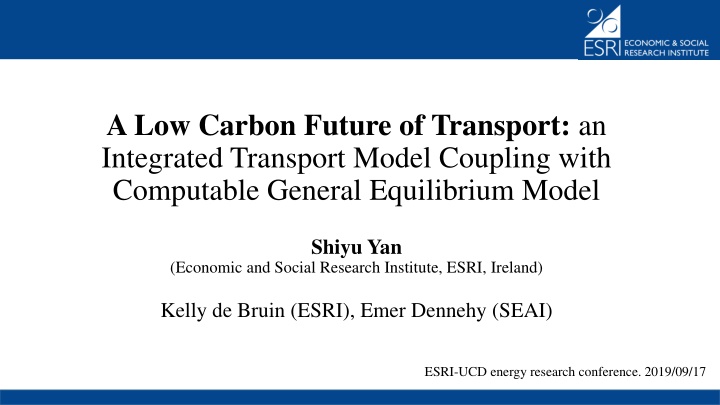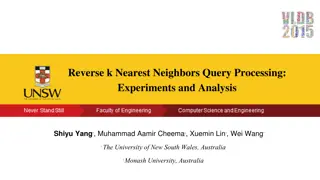
A Low Carbon Future of Transport: Integrated Model for Sustainable Transition
Explore the integrated model coupling transport and general equilibrium models to facilitate sustainable transitions in the transport sector. Quantify impacts, evaluate policies, and provide decision-making tools for energy efficiency and emission reduction.
Download Presentation

Please find below an Image/Link to download the presentation.
The content on the website is provided AS IS for your information and personal use only. It may not be sold, licensed, or shared on other websites without obtaining consent from the author. If you encounter any issues during the download, it is possible that the publisher has removed the file from their server.
You are allowed to download the files provided on this website for personal or commercial use, subject to the condition that they are used lawfully. All files are the property of their respective owners.
The content on the website is provided AS IS for your information and personal use only. It may not be sold, licensed, or shared on other websites without obtaining consent from the author.
E N D
Presentation Transcript
A Low Carbon Future of Transport: an Integrated Transport Model Coupling with Computable General Equilibrium Model Shiyu Yan (Economic and Social Research Institute, ESRI, Ireland) Kelly de Bruin (ESRI), Emer Dennehy (SEAI) ESRI-UCD energy research conference. 2019/09/17
Content 1. Introduction 2. Methods 3. Results 4. Conclusion
1. Introduction The importance of transport sector IEA(2016) 3
1. Introduction Total final energy consumption in Ireland by sector 4
1. Introduction Energy-related CO2 emissions in Ireland by sector 5
1. Introduction The project objective is to establish a integrated model of transport demand, energy consumption and emission to improve decision making in the sustainable transition of transport sector. quantify impacts of external socio-economic developments; evaluate effects of policy packages on transport and other economic activities; provide tools for decision makers to calculate transport energy and emission; present detailed transport energy scenarios in modal and technologies. 6
1. Introduction Research contributions: - Macro-economic and energy system wide top down models bottom up approaches with sectoral details. Global Change Assessment Model (GCAM) (Mishra et al., 2013) UK transport carbon model (Brand et al., 2012) - Panel data for parameter estimation and simulation - Integration of behavioral realism (logit models) - Link the transport (energy) model with a general equilibrium model (I3E) 7
2. Methods An integrated modelling framework Transport activity, energy, and emission passenger (Car, bus, rail, air) and freight (LGV, HGV, rail, navigation and air) Freight transport demand (tkm) and freight vehicle stock 8
Number of vehicles by class and technology Vehicle Stock Module (new sales, scrapped vehicles) Scenario variables I3E Model (e.g. GDP, income, demographics , prices) Transport demand by mode and vehicle class Transport Demand Module (forecast and disaggregation) Fuel Consumption Module (aging, on-road and driving condition) Energy use by fuel type Policy variables (e.g. vehicle taxes, energy taxes, carbon taxes, energy targets) In-use and life- cycle emissions by pollutants Emission Module (GHG and other pollutants) Transport Model 9
2. Methods 2.1 Freight Transport Demand Module 2.2 Freight Vehicle Stock Module 2.3 Freight Vehicle Fuel Consumption/Emission Module
2. Methods - Transport Demand Module (freight) Total transport service demand (tkm) Freight transport Rail Road Diesel Petrol Others Demand Share Discrete choice model Weight band LGV1 Weight band LGV1 Weight band HGV5 Weight band HGV5 10 weight bands Generalized price (euro/tkm) Vintage 1999 Vintage 2050 52 years of registration
2. Methods - Transport Demand Module (freight) Total transport service demand (tkm) - Discrete choice model Transport service price (euro/tkm) ?? ?? ??,? Share of total transport service demand (tkm) by mode/technology, i. ??,?= ?? ??? ??,? t is year ? is estimated from regression ? is calibrated for the baseline year 2015
2. Methods - Transport Demand Module (freight) Generalized price A generalized price is a share-weighted average price that is aggregated from prices on the lower level, j, in the nested structure based on the transport service demand share of vehicle technologies. ??,?= ??,?,???,?,? ? Road - Vehicle price, vehicle taxes, fuel costs and other costs. Rail Revenue/distance
2. Methods - Vehicle Stock Module (freight) Transport service demand by fuel, weight band and year of registration New vehicles Freight vehicle stock Survive rates by weight band and age Old vehicles
2. Methods - Vehicle Stock Module (freight) Energy efficiency by mode, fuel type, vehicle weight and year of registration Old vehicle energy efficiency (litre/km) increases along with the age. (LGV and HGV) New vehicle energy efficiency decrease considering the euro standard for vehicles. (LGV and HGV)
2. Results (Preliminary) - Descriptive analysis L1: <1017 kg L2: 1017-1270 L3: 1271-1524 L4: 1525-1778 L5: 1779-2032 H1: 2033-5080 H2: 5081-7112 H3: 7113-10160 H4: 10161-12192 H5: >12193
2. Results (Preliminary) - Descriptive analysis New vehicle survival rate
2. Results (Preliminary) - Descriptive analysis New vehicle energy efficiency
2. Results (Preliminary) - Projection Total freight transport demand (tkm) Base year
2. Results (Preliminary) - Projection Total freight transport demand by transport mode (tkm)
2. Results (Preliminary) - Projection Total freight transport demand by vehicle weight and fuel (tkm) Year of 2016 Diesel
2. Results (Preliminary) - Projection The number of goods vehicles by vehicle weight band and fuel Year of 2016 Diesel
2. Results (Preliminary) - Projection Business As Usual Fuel related taxes (carbon tax, fuel taxes and diesel rebate scheme) Vehicle taxes Fuel economy/emission standard

